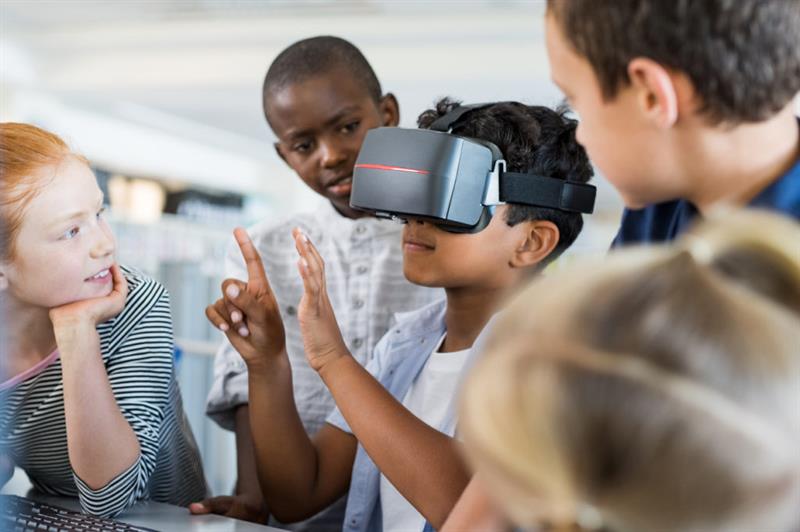However, technology alone is not a solution and if it is to be deployed effectively there needs to be a clear plan and much greater clarity in terms of how it is deployed and used by schools, and that is certainly a challenge for many institutions.
Critically, technology should not be seen as a single solution but should be seen as supporting existing initiatives, helping to empower teachers, so there needs to be clear goals, outcomes and deliverables.
A big part of delivering the benefits of technology is to ensure that staff are better trained and supported - there have been too many poorly implemented projects and many head teachers are said to be losing faith, both in the technology and the levels of investment that are required.
There is no doubt Edtech is changing the way lessons are delivered and will be integral to the classroom of the future. However, there is still a lack of awareness among many teachers of the capabilities that EdTech can offer.
“Where EdTech has been successfully adopted, it is being used to deliver curriculum in an engaging way through teaching aids, online applications and hands on experiences for students,” explains James Howarth, Head of Education at RS Components. “However, EdTech is a term that’s not wholly understood by many teachers and many are hesitant to invest in technology.”
According to Jenny Featherston, user researcher and UX consultant at Sigma, a specialist developer of VR and AR technology, “While EdTech has a positive perception in terms of impact on teacher workload and student experience and whilst many learning institutions are equipped with the latest technology, there is often a widespread gap in teacher proficiency which means that these resources are often under-utilised and don’t always delivery their full potential benefits.”
The EdTech Report, published by RS Components in 2019, reinforced that perception. Despite plans for a £10 million UK government strategy for
EdTech in schools, there is a widespread lack of understanding when it comes to educational technology amongst teachers.
The survey found that while half of teachers said they knew what EdTech was, over a third, despite having heard of it, didn’t know what it was. A worrying 14% said that they had never heard of EdTech.
These figures are likely to change as the next generation of teachers enters the education system, many of whom will be digitally ‘savvy’ and can be expected to put growing pressure on schools to embrace technology and to be more innovative in the way that children are taught.
“While today, schools are continuing to invest in traditional hardware such as desktop computers and increasing the use of smart boards, tablets and other mobile devices, there is now a significant uptake of learning apps to assist in delivering curriculum,” suggests Howarth. “These learning apps enable teachers to create lessons, set homework, create dashboards and give grades and feedback. Content can then be easily accessed by students in the classroom or at home.
“In addition, more technology is being used to teach core skills in computer science and design technology, from utilising robotics to teach coding or 3D printing to bring designs to life.”
The Use of robotics
The use of robotics in the classroom has been a significant development in recent years.
MARTY is a fully programmable, Wi-Fi enabled walking robot that has been designed to be compatible with a wide range of microcomputers such as the micro:bit, the Arduino and Raspberry Pi.
It’s the flagship product of a UK company, Robotical, and has been designed for children eight years and older.
“MARTY can be used as a standalone educational tool, or as we recommend, in groups to help children develop team working skills, alongside learning how to code,” explains the company’s founder and CEO, Sandy Enoch.

Above: MARTY is a full programmable Wi-Fi enabled robot
Robotical provides supporting materials that address and fit alongside a broad curriculum of Computer Science, Design and Technology, IT and Engineering education for teaching, not just beginners but right through to advanced university level, according to Enoch.
“The EdTech sector is growing rapidly and it is now a giant global market and we’re seeing more schools embracing technology, whether enabling technology, like iPads, to more disruptive technologies like robotics and other technologies that look to enhance the educational experience.”
The role of government in driving the adoption of technology is mainly associated with curriculum development and tends to vary from country to country, according to Enoch.
“It’s more at the local level, particularly in the UK,” he explains. “Here the adoption of technology tends to be on a school by school basis, driven by head teachers looking to address the STEMs skills gap.
“Schools know that they need to do more to get kids prepared for a rapidly changing work market, and technology is certainly one way to
encourage more children to look at STEM and to get a better mix of students, in terms of gender and background.
“MARTY has been designed to have a character and we’ve found that it certainly has a strong gender appeal.
“We have been working with a number of schools and while we do talk to IT providers our engagement tends to be directly with them. Typically, we let schools try out MARTY to see whether it’s a good fit and we offer further support through providing training workshops and coaching for teachers.”
The training of teachers was highlighted in the RS EdTech Report which found that despite advances in educational technology in schools, many teachers were struggling to adapt to these new ways of learning because of a lack of training, meaning schools are at risk of investing thousands of pounds in EdTech that will fail to deliver.
The report found that the lack of teacher training was most evident at Academy schools, where 60% said they didn’t think there was enough training available when it came to technology.
This was a similar scenario for teachers at public schools, with over half (54%) saying they didn’t believe there was enough training available.
“Whilst some Edtech providers offer a variety of training platforms for teachers through online tutorials or hands on CPD, there are many teachers who do not believe they receive sufficient training for the equipment they have,” says Howarth.
“It is vital that schools invest in providing relevant training to support the implementation of Edtech and ensure teachers can benefit fully from the technology, and deliver with confidence in the classroom.”
Enoch agrees. “For engagement to work there needs to be buy-in from teachers and there is a lot of fear when it comes to using new technology. Often schools will spend a lot to bring technology into play, but then under-utilise it because teachers find it hard to use or simply don’t know how to use it.”
Teaching aids are available, many of which will be tied to curriculum needs, but as Enoch suggests, “a lot depends on the type of school or the headteacher – there are thousands of schools across the UK and not all of them will be looking to address problems through technology.”
At a time of budgetary restraint for many schools, those most in need will be spending their limited budgets elsewhere.
“More could be done at the central level,” Enoch suggests, emphasising the importance of on-going teacher development.
AI and data
“The coming years will see technology continue to disrupt the way we live and work, meaning there will be more emphasis in schools to use Edtech to prepare students for a digitally driven world,” says Howarth.
“The demand from industry will increase the need for students to learn digital skills which can be delivered both in the classroom and virtually. This can only be achieved with an increased uptake of Edtech in schools and the continued development of technology in this space.”
“The potential of AI in the classroom environment is huge, from personalising learning experiences to reducing teacher workload. But despite Government exploration groups and some inspiring examples of use, it’s fair to say it’s still in its infancy compared to other sectors. The next 5 to 10 years will undoubtedly see a shift in how we think about these technologies and their central role in the classrooms of the future and the current Covid-19 situation will most likely accelerate that thinking,” says Featherstone.
Technology can certainly help improve access to education and the use of digital textbooks means they can be accessed online as and when they are required, and digital copies are relatively cheap to produce.

Above: Extended reality will bring immersive learning experiences to students
Technology can also make it far easier to tailor and provide differentiated learning which allows students to be taught in a way that meets their own personal needs.
Extended reality encompassing virtual, augmented, and mixed reality will also bring immersive learning experiences to students,
If teachers are able to access a variety of learning tools through technology they will then be able to give students a far more differentiated learning experience.
The use of technology can also help institutions and educators to be more effective and efficient though analysing data derived from how digital resources are consumed or which educational technologies are used.
As students interact with connected IoT devices and other digital tools, for example, so more data will be gathered and that can then be used to enhance lessons. It will also make it easier to identify those technologies, or tools, that simply aren't effective.
Big data, machine learning, and artificial intelligence, will be able to provide for more in-depth personalisation of the content for an individual's learning needs and provide students with more support where, and if, its required.
A £4.6 million funding programme has been unveiled by the Department for Education (DfE) to test EdTech in classrooms in the hope that this will kick start innovation and de-risk future investment by technology suppliers, as well as schools, helping make schools more educated consumers when it comes to technology solutions.
But, as with many sectors, the growing use of technology will also see increased cybersecurity threats, potentially posing a risk to student data and day-to-day operations. In response, schools will need to introduce robust cybersecurity and business continuity strategy employing encryption, managed cloud services and better levels of authentication to limit and contain these threats.
“Over the next five to ten years we will see the development of AI for personalised learning, reduction in teacher workload, automation of tasks, insight into student performance, identifying intervention needs,” suggests Featherstone.
“With little warning Covid-19 has resulted in the majority of children being educated remotely with schools adopting technology to deliver the best learning experiences they can during this new, albeit temporary, reality. “Schools in the UK have obviously been embedding digital learning into
their classroom practice for years, but many will be on a very steep learning curve right now,” she suggests.
“For some this will enforce a shift in mind-set and a brave leap into a world they may have been hesitant to embrace but for others it’s a welcome opportunity to think creatively, to share and seek best practice from the global community and to look at new and emerging ways to embed technology into their teaching and learning.”













